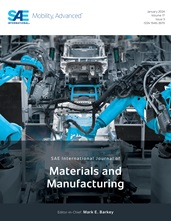Optimization of Arc Welding Parameters for FB590 Hot-Rolled Ferritic-Bainitic Steel with 2.5 mm Thickness
- Features
- Content
- In this study, the optimization of robotic gas metal arc welding (GMAW) parameters for joining hot-rolled ferritic-bainitic FB590 steel sheets with a thickness of 2.5 mm was investigated. The main objective was to evaluate the effect of wire feed speed and welding speed on the penetration depth, throat thickness, and mechanical performance of the welded joint. A series of welding experiments were carried out with wire feed speeds ranging from 50 cm/min to 100 cm/min and welding speeds ranging from 5 cm/min to 15 cm/min. Tensile and microhardness tests were carried out to evaluate the structural integrity of the welded joints. The results show that increasing the wire feed speed significantly improves the weld penetration and throat thickness, especially at constant welding speeds. The most suitable combination was found to be 70 cm/min wire feed at 8 cm/min travel speed and 100 cm/min wire feed at 12 cm/min and 15 cm/min travel speeds. The microhardness in the heat-affected zone reached a maximum of 223 HV, while the tensile shear strength remained constant over all parameter ranges tested, indicating stable joint performance. These findings are consistent with previous literature and highlight the importance of precise parameter control in the welding of high-strength steel. This study provides valuable information for automotive applications where weld quality and repeatability are critical.
- Pages
- 7
- Citation
- Babir, N., and Üzel, U., "Optimization of Arc Welding Parameters for FB590 Hot-Rolled Ferritic-Bainitic Steel with 2.5 mm Thickness," SAE Int. J. Mater. Manf. 19(3):1-7, 2026, https://doi.org/10.4271/05-19-03-0018.
